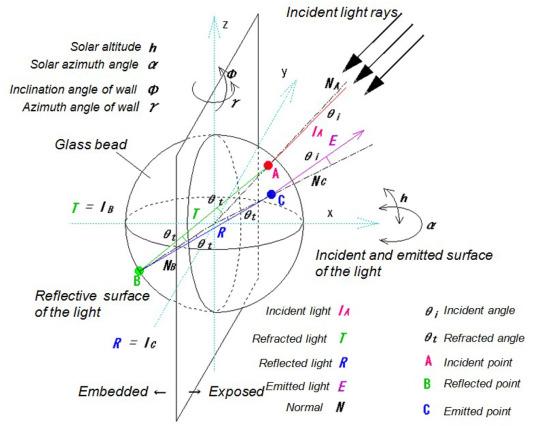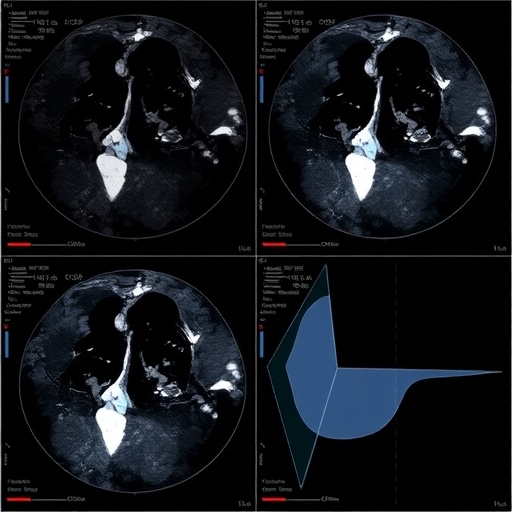Prediction of the upward-to-downward reflection ratio of glass bead retro-reflective material applied to the outer walls of buildings

Credit: COPYRIGHT (C) TOYOHASHI UNIVERSITY OF TECHNOLOGY. ALL RIGHTS RESERVED.
Overview:
Jihui Yuan (Assistant Professor, Department of Architecture and Civil Engineering, Toyohashi University of Technology) proposed a numerical bead model to predict the upward-to-downward reflection ratio of glass bead retro-reflective (RR) material purposed for urban heat island (UHI) mitigation and reducing energy consumption. It revealed that the retro-reflectivity of glass bead RR material gradually increases from morning to noon, at which time it begins to gradually decrease. These results will contribute to existing research on the absorption or reflection of solar radiation to improve urban thermal and lighting conditions, and to reduce building energy consumption.
Details:
Various measures for UHI mitigation and reduced building energy consumption have been widely implemented. Further, the solar reflectivity of the surrounding pavement and outer wall surfaces of a building are reported to be important factors that affect the air-conditioning load of the building, which is directly related to its energy use. Rooftops covered with diffuse highly reflective (DHR) materials (i.e., highly reflective paints) can reflect solar radiation to the sky if there are no high buildings in the vicinity. However, if there are high buildings nearby, much of the solar radiation will be reflected to neighboring buildings and roads, where it will be absorbed to exacerbate the UHI phenomenon. Thus, although DHR materials are widely applied to building facades, RR materials have been recommended as a replacement to mitigate the UHI phenomenon and reduce building energy consumption.
However, RR materials are still in the research and development phase and have not been used practically. Most research indicates that when the incident angles of sunlight become very large, the RR capacity is critically reduced, and the downward solar reflectivity, such as specular reflectivity, increases. In addition, the downward solar radiation from building facades not only negatively impacts pedestrians, but it also heats the urban environment through the heat absorbed by the ground surface; thus, downward solar radiation is regarded as a major contributor to the UHI phenomenon. Therefore, in consideration of how much a change in incident angle can affect the RR capacity and downward solar reflectivity of RR materials, a comprehensive prediction is needed.
Thus, Assistant Professor Jihui Yuan within the Department of Architecture and Civil Engineering at Toyohashi University of Technology, in collaboration with researchers at Osaka City University, proposed a glass bead numerical model to predict the upward-to-downward reflection ratio of glass bead-type RR materials. The results of this study have been published online in advance in the Elsevier journal Urban Climate in March 2021.
As mentioned previously, to better understand the reflection principle of glass bead-type RR materials, a glass bead numerical model was developed and simulated. The simulation was performed to evaluate glass bead-type RR material sunlight reflection by analyzing the retro-reflectivity and upward-to-downward reflection ratio of glass beads.
Future Outlook:
Future work will focus on exploring methods to suppress the downward reflecting light and on attempting to develop the RR materials that can minimize it. Future work will also focus on the development of more accurate models for the evaluation of the RR properties of RR materials, and on performing actual optical measurements of RR materials.
If we can predict directional reflection characteristics of RR materials applied to building facades, such as the upward-to-downward reflection ratio, then we would be able to apply these RR materials to the exterior surfaces in different directions to optimize the absorption or reflection of solar radiation; this would ultimately improve urban thermal and lighting conditions, and reducing energy consumption.
###
Funding agency:
This work has received financial support from the Japan Science and Technology Agency (Grant number: JPMJTM20EE), and Education and Research Activation Foundation (Youth Studies) of Toyohashi University of Technology in Japan. The authors are grateful for their financial support.
Reference:
Jihui Yuan, Kazuo Emura and Craig Farnham (2021). Evaluation of retro-reflective properties and upward to downward reflection ratio of glass bead retro-reflective material using a numerical model. Urban Climate, Vol. 36, March 2021, 100774, DOI:
10.1016/j.uclim.2021.100774.
Media Contact
Yuko Ito
[email protected]
Related Journal Article
http://dx.




